1
MiningFor a period of time, the development of the mining industry appeared to have a bright future in this area of the North Shore. Much money and energy was invested into developments, which all too often ended in disappointment.
Today, the only mining is of salt - salt mining is continued at Pugwash in Cumberland County . After the Malagash salt mine closed, many of the workers went to Pugwash.
2
MINING - Mineral Distribution Map, North Shore, Nova Scotia, Canada1984
North Shore, Nova Scotia, Canada
 Credits:
Credits:Roy Kennedy
North Shore Archives, Tatamagouche
3
Copper MinesAfter their arrival in 1710 the Acadians attempted smelting the small quantities of copper they found in scattered places in the area, with little true success. Some 75 years after the deportation of the Acadians, the search for copper ore began again, in earnest this time.
The Acadians had a copper mine site on the Mine Hole Brook, where it joined with Waugh's River, and by 1860, the presence of ore sparked the interest of American investors. The mining rights were bought between 1865 and 1867 by Cullen Ayer of Boston, Mass. In 1867 he sold the property to the Boston Mining Association, making an impressive profit (paid $2000, received $35000). The mine was ill-fated; the brook quickly flooded the site. Water was drained to extract enough ore to load a 100-ton schooner, but the schooner got trapped in the frozen waters off Steele's Island (near Tatamagouche) and caught fire. The crew escaped, but many ashore thought that the prospect of spending a winter stuck in the ice with a load of ore, was too much for the crew! Years later lumps of the ore were salvaged along the shore by another mining company.
4
Copper: Mine Hole Brook, Waugh's River, Nova Scotia, Canada1700's to 1900
Waugh's River, Nova Scotia, Canada
 Credits:
Credits:North Shore Archives CSHC
5
In 1894, work was done in the Waughs River area by engineer and surveyor E.L.W. Haskett-Smith. He sent large samples to England but little more development occured. In 1905, the Sterling Mining Company worked on the Black Brook, not far away. By 1907, an estimated 650 tons of ore was mined and 240 tons were shipped to the United States in 1908.6
Porteous Copper Mine Site, Oliver, Nova Scotia, Canada14 July 2010
Oliver, Nova Scotia, Canada
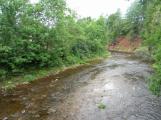 Credits:
Credits:R. Campbell
7
The copper mine site shows no evidence of its former activity.Abraham Patterson was the father of the North Shore's copper mining industry. Involved in the lumbering industry in the early 19th Century, he acquired various plots of land in the region and one on the French River was actually worked in 1838. John Switham had been working the site for some time, so Patterson had an agreement with him, paying him a percentage of the ore already mined and any future ores extracted
In 1851 Abraham Patterson purchased a saw mill and dam at Porteous Bridge, Oliver, where in 1857 copper was found in the west bank of the French Rriver, a short distance downstream from the mill. Assay reports on the ore were good., Patterson took out a 30 year lease to mine the ore, and by 1866 a quantity of ore had been mined and shipped to England. He actually made little profit on the venture, and sold the lease.
8
Copper Ore Rocks, New Annan, Nova Scotia, Canada2 June 2010
New Annan, Nova Scotia, Canada
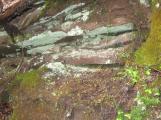 Credits:
Credits:Jim MacIntosh
9
In 1876, a Mr. Pendergast took over the management of the Porteous Bridge copper mine. The copper was extracted from the sandstone,in walnut-sized chunks,then broken with sledgehammers. The result was sent to New York for processing. After shipping between 18 and 19 tons of copper, the mine was abandoned and little more development was done in the area..
10
Copper Crown Company, New Annan, Nova Scotia, Canada19th Century
Black Brook, New Annan, Nova Scotia, Canada
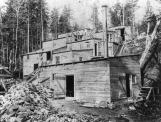 Credits:
Credits:North Shore Archives CSHC
11
A new mining venture emerged in New Annan, first reported in 1894. The new company was the American owned Copper Crown Mining Company, headed by a Mr. Parker of Amherst, Nova Scotia. In 1899 there was already talk of employing more men, and more buildings were being erected. The company was also working in Wentworth, Oxford, and River John. A smelter was being built in Pictou. The Company spent $200 000 on the ventures and planned to branch out into gold mining.12
Site of Copper Mine, New Annan, Nova Scotia, Canada2 June 2010
New Annan, Nova Scotia, Canada
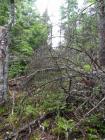 Credits:
Credits:Jim MacIntosh
13
The men at Copper Crown Mining Company worked around the clock to fill orders, two shifts of six men per day. They stockpiled more than 600 tons of copper ore. The work would slow down if lumbering contractors could not supply the necessary lumber to do the required building on the site. They employed sailing vessels to carry out their shipments. (It is interesting to note that they did not use the Short Line railway, which would have provided faster and safer transport.) Engines and equipment arrived regularly, and more men became employed. Boarding houses were in demand and carpenters also found employment in the mines.The site today shows little evidence of former activity.
14
Abandoned Mine Shaft, New Annan, Nova Scotia, Canada2 June 2010
New Annan, Nova Scotia, Canada
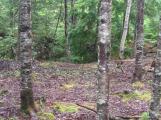 Credits:
Credits:Jim MacIntosh